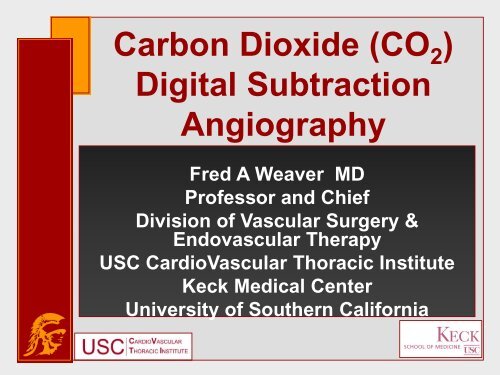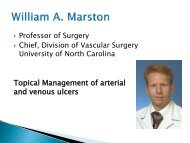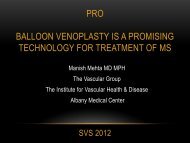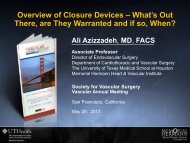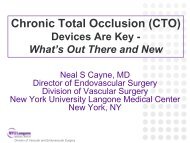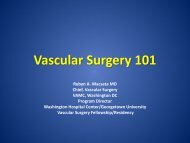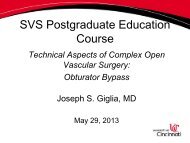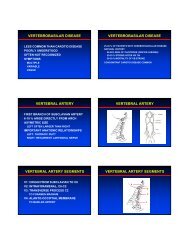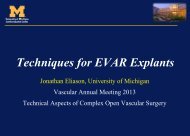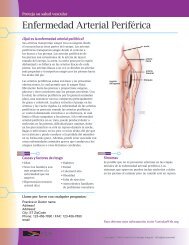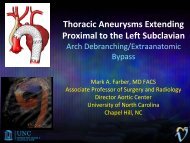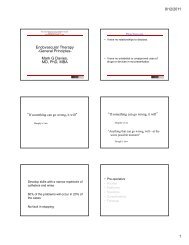CO2 Angiography - VascularWeb
CO2 Angiography - VascularWeb
CO2 Angiography - VascularWeb
You also want an ePaper? Increase the reach of your titles
YUMPU automatically turns print PDFs into web optimized ePapers that Google loves.
Carbon Dioxide (CO 2 )<br />
Digital Subtraction<br />
<strong>Angiography</strong><br />
Fred A Weaver MD<br />
Professor and Chief<br />
Division of Vascular Surgery &<br />
Endovascular Therapy<br />
USC CardioVascular Thoracic Institute<br />
Keck Medical Center<br />
University of Southern California
Disclosures<br />
Fred A Weaver MD<br />
Nothing to Disclose
Objectives<br />
• Contrast Nephrotoxicity<br />
• CO 2 <strong>Angiography</strong> Technique<br />
• CO 2 <strong>Angiography</strong> Applications
Mortality stratified by contrastinduced<br />
nephropathy<br />
From A M et al. Mayo Clin Proc. 2008;83:1095-1100<br />
© 2008 Mayo Foundation for Medical Education and Research
Thirty-day mortality rates with different types of radiographic procedures and routes of<br />
contrast administration, stratified by presence of diabetes mellitus (DM) and elevated<br />
creatinine<br />
© 2008 Mayo Foundation for Medical Education and Research<br />
From A M et al. Mayo Clin Proc. 2008;83:1095-1100<br />
A. CT with IV B. Coronary C. Venography D. Non cardiac Angio
Carbon Dioxide as<br />
Intravascular Contrast Agent<br />
• Used in 1950’s<br />
• Diagnosis of pericardial effusion<br />
• 100-200 bolus of CO 2<br />
intravenous<br />
• Trapping of CO 2 in Right Atrium
CO 2 Advantages<br />
• Inexpensive<br />
• Widely Available<br />
• Highly Soluble in blood<br />
• Eliminated via lungs<br />
• No nephrotoxicity<br />
• No allergic reactions<br />
• Low Viscosity (smaller catheters)
• Fill bag 3x directly<br />
• Fill 60cc syringe 3x<br />
• Self contained,<br />
closed one –way<br />
valve system<br />
• Room air<br />
contamination<br />
minimized
Technology Requirements<br />
• Digital, Flat Panel<br />
• Increased frame rate, 3 to 6<br />
frames per second, stacking<br />
technology is required<br />
• Fixed dedicated angiographic<br />
equipment, portable C-arm<br />
inadequate
Technique<br />
• Hand inject < 50 cc<br />
• Closed, self contained system<br />
• Change position of patient for<br />
clearing<br />
• Allow reabsorption time<br />
• Decrease volume around viscerals
Vapor Lock<br />
• CO 2 bouyant gas<br />
• Filling of non-dependent vessels<br />
• Bouyancy > Energy of Blood<br />
flow = trapped gas “vapor lock”<br />
• Increased with room air<br />
contamination<br />
• Use of a self contained system<br />
reduces room air contamination
Applications of Carbon<br />
Dioxide <strong>Angiography</strong><br />
• EVAR<br />
• Renal<br />
• Peripheral<br />
• TIPS<br />
• Vena Cava and Hepatic<br />
venography
Iodine vs CO 2<br />
Iodine CO 2
Endoleak<br />
Iodine CO 2
Results<br />
Moos, Arch Surg. 2011;146(12):1428-1432<br />
• 1988 - 2009<br />
• 951 patients<br />
• 1,007 cases using CO 2<br />
• 519 Iodine<br />
• Average age: 64 years old<br />
• Male: 60.4%
Angiograms (1007)<br />
100<br />
70<br />
5<br />
305<br />
527<br />
Aortograms with/without LE run-off<br />
Cavagrams<br />
Extremity alone<br />
Splanchnic venograms<br />
Pulmonary
Interventions (499)<br />
98<br />
162<br />
176<br />
Arterial interventions<br />
IVC filters<br />
TIPS
Contrast used, by procedure<br />
Procedure (n)<br />
CO 2 alone<br />
(%)<br />
Median<br />
(mL)<br />
CO 2 +<br />
Iodine (%)<br />
Median (mL)<br />
Aortography (527) 246 (46.7) 240 281 (53.3) 15<br />
Renal/visceral<br />
PTA/Stent (53) 12 (22.6) 225 41 (77.4) 10<br />
Extremity PTA/stent<br />
(41) 31 (75.6) 180 10 (24.4) 4<br />
EVAR (62) 21 (33.9) 180 41 (66.1) 30<br />
TIPS (98) 27 (27.6) 100 71 (72.4) 125<br />
TJLB (54) 48 (88.9) 60 6 (11.1) 10<br />
IVC (176) 170 (96.6) 60 6 (3.4) 3<br />
Hepatic venography<br />
(30) 25 (83.3) 60 5 (16.7) 30
Complications<br />
18<br />
14<br />
4<br />
4<br />
6<br />
9<br />
16<br />
Abdominal pain<br />
Transient hypotension<br />
Renal failure<br />
Puncture site hematoma<br />
Nausea<br />
Death<br />
Misc Other
Complications<br />
• Total: 6%<br />
• Puncture site hematoma = 16 (1.6%)<br />
CO 2 specific complications<br />
• Abdominal Pain = 14 (1.4%)<br />
• Transient = 10<br />
• Pancreatitis = 4 (3 resolved)<br />
None since self contained, closed system<br />
adopted
Complications<br />
• Deaths = 4 (0.4%)<br />
Metastatic adenocarcinoma<br />
Refractory cardiomyopathy<br />
TIPS/Left hepatic perforation<br />
Suppurative pancreatitis
Pre-op and Post-op Renal<br />
Function<br />
35<br />
33 32<br />
30<br />
25<br />
20<br />
15<br />
10<br />
5<br />
2.1 2.1<br />
BUN<br />
Creatinine<br />
0<br />
Preop<br />
Postop
Comparison of preoperative and<br />
postoperative creatinine values<br />
Preprocedur<br />
e<br />
creatinine<br />
(mg/dL)<br />
n (%)<br />
preop cr,<br />
mean<br />
± SD<br />
(mg/dL)<br />
postop cr,<br />
mean<br />
± SD<br />
(mg/dL)<br />
P<br />
value<br />
Rise in Cr<br />
(>0.5), n<br />
Δ, mean<br />
± SD<br />
2<br />
245<br />
(35)<br />
3.1 ± 1.3 3.2 ± 1.6 NS 27<br />
0.19 ±<br />
0.91<br />
Total 700 2.1 ± 1.2 2.1 ± 1.4 NS 44
Conclusions<br />
• CIN is significant and potentially lethal entity<br />
• CO 2 applications for diagnostic and<br />
interventional procedures are safe<br />
• CO 2 as a contrast agent effectively preserves<br />
renal function<br />
• CO 2 should be considered for patients with renal<br />
dysfunction<br />
• With the exception of hydration only documented<br />
preventative strategy to prevent renal<br />
dysfunction<br />
• Room air contamination responsible for majority<br />
of CO 2 mediated complications, self contained<br />
closed system important


